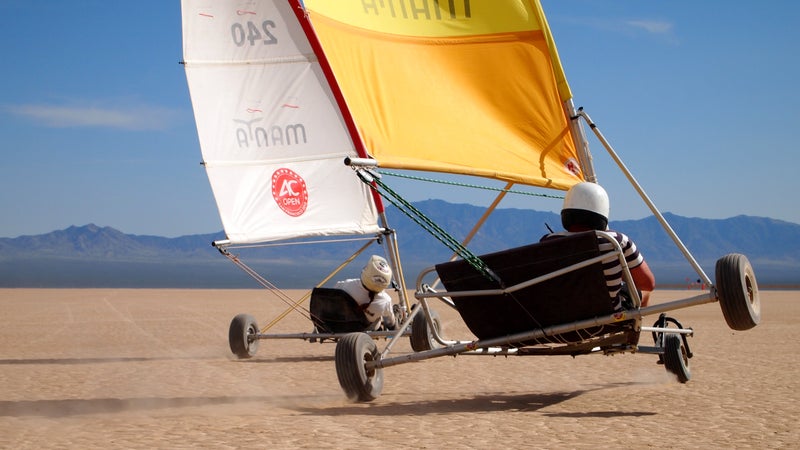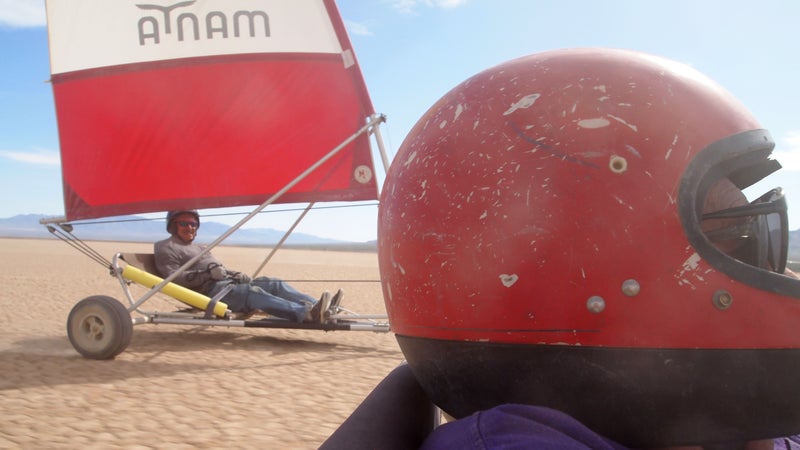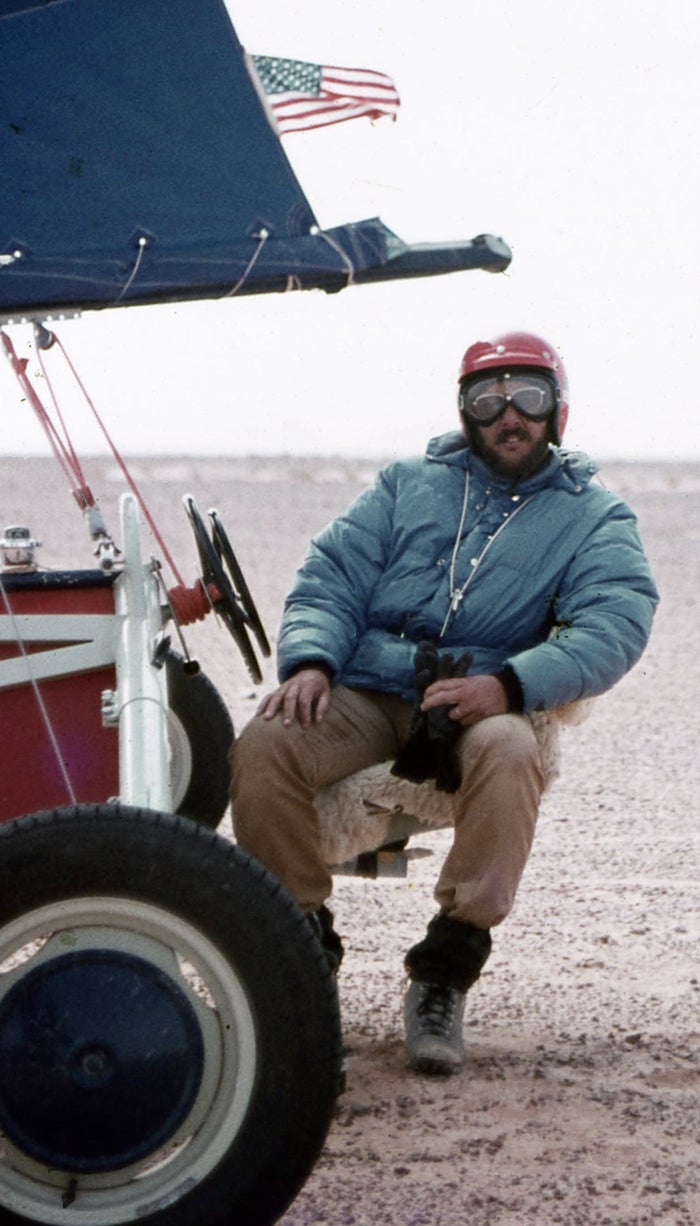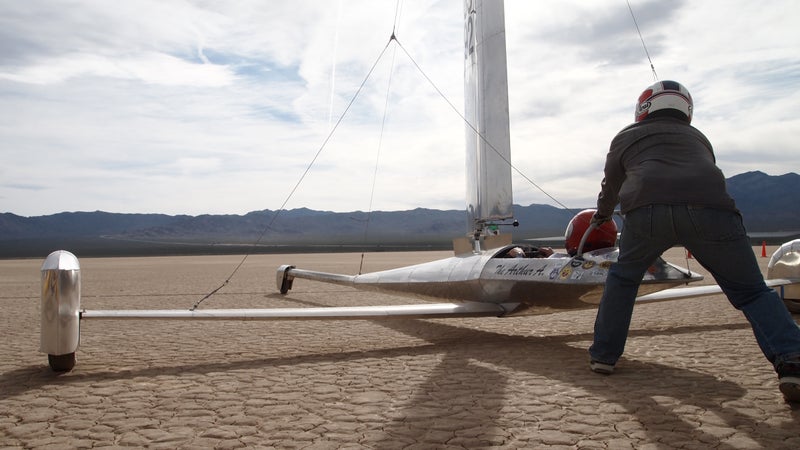On the Ground at Land Sailing’s Title Race
A group of eccentric engineers flocked to a dried-up lakebed in California to race for the championship title of a 117-year-old sport you’ve never heard of
New perk: Easily find new routes and hidden gems, upcoming running events, and more near you. Your weekly Local Running Newsletter has everything you need to lace up! .
I put on a motorcycle helmet and buckle into what’s basically a 12-foot-long beach chair affixed to three wheels and a sail. My feet rest on pedals that steer the tiny front wheel, and I point the contraption across the dry lakebed toward a distant peak. After I give it a few kick-pushes to get the thing moving, the sail catches a gust of wind and I take off.
Within seconds, I’m shooting across the desert at highway speeds. I feel the acceleration in my chest. Chunks of dirt batter my face. The lifting sail pulls one of the rear wheels off the ground. I cling to that side to avoid flipping. It’s my first spin in what is known to those who build them as a land yacht or dirt boat. It’s a Friday in late March, and a coterie of dirt boaters has flocked to the Ivanpah Dry Lake on the California-Nevada border to race for the title of national champion in the 41st America’s Landsailing Cup.

If you’ve never heard of land sailing before, you’re forgiven. The sport gained traction in Europe in the early 20th century. To this day, Mazda sponsors land-sailing teams across the Atlantic. But it never really caught wind in the United States, and today it’s relegated to a handful of haphazard events held in the dustiest parts of the West. Many of these “sailors” (a number of which are water sailors as well) have spent the bulk of their lives manipulating the desert winds and have forgotten that when most people think of sailing, they imagine madras pants and snobbery—essentially the judge in Caddyshack. But when I discovered land sailing, I was immediately intrigued. Traditional sailing is a vaunted activity of well-heeled bluebloods whose surnames call to mind the regality of the nation’s Founding Fathers. Land sailing, by comparison, looks like sailing’s wayward, mutant disciple and is relegated to the venues you’d last think to spend a fun weekend away. Why isn’t it better known? I had to find out what has kept it so well hidden.
Land sailing is a lot like traditional sailing in the way it’s raced, but way faster and generally carried out in homemade rigs. Ivanpah is the site of the sport’s current speed record of 126 mph, set by a British engineer in 2009. By comparison, sailors racing for glory in multimillion-dollar catamarans in the America’s Cup top out at about 55 mph. Land sailing’s helmeted drivers are called pilots, not skippers, and look more Formula One than yacht club; the sport is a marriage of the two.

Pioneers and neophytes alike construct a DIY village at Ivanpah—the scene is like Burning Man for speed freaks. Land sailors refer to these desert forays as “pilgrimages,” which makes the sport something of a religion. A 60-year-old retired carpenter from Santa Cruz, California, named Duncan Harrison had invited me to stay in his camper. Harrison, with a sun-worn visage and an impish laugh, is land sailing’s loyal chronicler—he founded the online journal Dirt Boating Magazine in 2013. The sailors spent the week racing and celebrating a pastime that in its centuries of existence has never become mainstream. And it may never if enthusiasts don’t find a way to inject the sport with new blood.
“It’s too remote a sport,” says former North American Land Sailing Association (NALSA) president Dennis Bassano. (NALSA hosts the lakebed race.) And it’s solely dependent on the weather conditions. “You get out there and there’s no guarantee it’ll blow,” Bassano says. “So they don’t have what it takes to wait, survive out there, and entertain yourself.”
As long as there’s been a wheel and a sail, people have pieced together terrestrial wind-powered vehicles. Paintings of wind carts have been found in the tombs of ancient Egyptian pharaohs. The Belgians used carts with sails as military troop carriers in the 16th century. The first documented land-sailing races took place in 1898, between Louis Bleriot, a famous French aviator, and the Dumond brothers of Belgium, some of the first automobile makers.
It wasn’t until after World War I and the advent of the pneumatic tire, which made the boats operational on varied terrain, that the sport rose in popularity in Europe. Ubiquitous abandoned airfields and surplus aircraft parts spurred competition. During the postwar era, jury-rigged land sailing popped up in the United States as cross-prairie transportation and pure fun.
The first land yacht models commercially manufactured in the United States, called the Desert Dart and the Sand Sailor, emerged in the late 1960s. The Dart was the first to have a “raked” mast, meaning it was angled backward to flatten the sails and better balance the boat. In 1974, hang-glider manufacturers invented the and, in 1976, the Manta Twin. These designs built on the legacy that came before them—light frames and efficient wings—and are still the go-to models today.
Land sailing’s rise in the United States is largely attributed to Don Rypinski, who raced with an international team of land sailors 1,800 miles across the Sahara Desert, from Algeria to Mauritania, in 1971. (National Geographic filmed and televised the feat in a special called .) Under his guidance, the nascent U.S. racing community attached itself to a preexisting European infrastructure. The first America’s Landsailing Cup hosted by NALSA, which Rypinski founded, was held at Roach Dry Lake in Nevada, just down the road from Ivanpah, in 1974.

In those days, steel and fiberglass were cheap, and many in the land-sailing community were engineers or craftspeople. Mad geniuses in the desert, they pushed the sport toward a competitive awakening. Before NALSA, competed against each other in dry lakebeds or airfields with homemade yachts built from water pipes and wheelbarrow wheels. Last summer, NALSA hosted in which scores of sailors from 47 different countries competed at Ivanpah.
Despite the international participation, the sport hasn’t taken off in the United States quite as Rypinski envisioned. Accessibility is at the heart of the problem. The French and Belgians take their children on field trips to coastal land-sailing schools and encourage membership in generations-old clubs with hundreds of members. Meanwhile, favored land-sailing spots—like the Smith Creek Playa, three hours east of Reno along Highway 50, dubbed “the loneliest road in America”—are just too remote to attract mainstream attention. Rypinski says the oil crisis in the early ’70s is partly to blame for stymying the sport in its infancy because it limited the distance people were willing to drive their gas-guzzling campers.
Today, land sailors are having difficulty securing places to host races and shelling out for general liability insurance. Appropriate sailing venues are far from populated areas and in regions where weather is fickle. Furthermore, perhaps most consequentially, NALSA hasn’t tried reaching out to young people. Sailors just bring newcomers when they can. “A lot of people don’t know we exist as a sport,” says Alan Watson, president of the International Land and Sandyachting Federation. “But our life is in getting youth involved.”
Sunday, two days after my first solo ride, is championship day in the desert. Spectators and some families arrive, including one group from Chile with three kids eager to compete. The few young people who learn the sport usually follow a parent into it and often have to travel a long way to race against others. Out of the desert, Rypinski appears with the “windbuggy” he built in 1958 and raced in Europe. He had turned 79 the day before. “I’m getting too old for this shit,” he says. “This thing isn’t competitive anymore, but neither am I.” He no longer races, but year after year, he shows up.
Flags from various countries’ land-sailing clubs hang on the wall of the race committee tent as Bassano begins the mandatory pilots’ meeting. The tent shakes in the violent wind, and the 70 or so racers inside clamor with restlessness. With gleaming trophies behind him, Bassano goes through the race rules—and some camp rules. “Watch your dogs,” he said. “Nobody likes your dogs when they pee on tools or wheels.”
“How do you know it’s the dogs?” someone yells. Harrison grins a knowing grin.

Race time: The Manta pilots line up to start and can barely hold down their boats in the gusts blowing out of the south. Strapped into their aluminum crafts and adorned with motorcycle helmets and motley protective getups, they look like a menacing road gang from Mad Max. Race committee head Mary Bassano, Dennis’ wife, drops the checkered flag, and the Mantas are off. At a far mark, one capsizes in a dirt cloud. As per the rules, the race counts as long as somebody completes a lap within 15 minutes. In ideal conditions, a race would be over long before then, but it’s a close call in today’s conditions. One by one, the pack sails across the line, trying to keep that windward wheel down and sending a wall of dust in front of some photographers—really just family members trying to capture the smiles on the finishers’ faces.
The afternoon is a revolving door of several boat classes going around the marks. The big boats, spaceship-looking and each of a unique design, rip around the course at 60 to 90 mph. “It’s kind of like a ballet,” Mary Bassano says. Spectators stand rapt in the grueling sun, completely absorbed in their esoteric ritual and the little world they’ve kept alive. I wonder if something so beloved could possibly die.
Contrary to Dennis Bassano’s theory that young people who might join land sailing are turned away by capricious weather conditions, it has become clear to me that U.S. land sailors themselves are responsible for keeping their sport hidden, if only involuntarily. They’re too busy doing it—traveling to and from the desert and building and maintaining their crafts—to concern themselves with marketing it. But it’s safe to say that even if NALSA were to collapse in a generation, there will still be pockets of people out there putting sails on wheels, and they’ll find ways to race their contraptions.
After his race, Harrison returns to camp glowing with adrenaline. Excited to have snagged a first-place finish, he sits down next to two friends. “Tears your arms out of their sockets,” he says of the intensity of steering. “Do this for a week and you’ll be walking like an ape.” As the sun goes down, I head out for another ride. Harrison yells after me, asking for my blood type.


